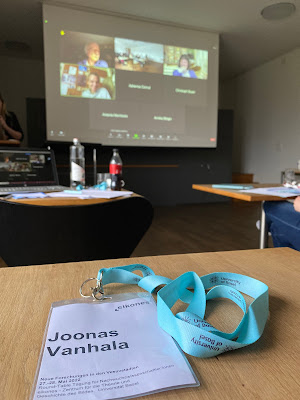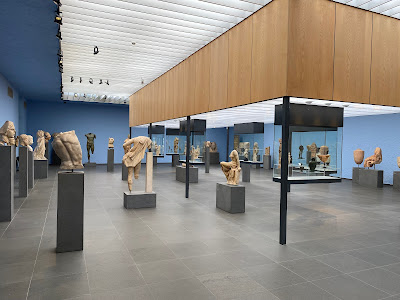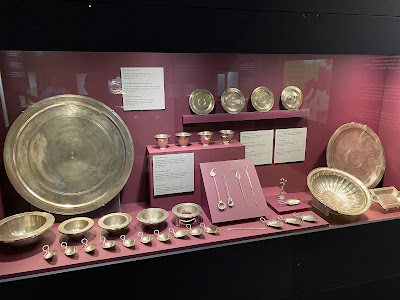I recently participated in a conference of PhD students who study the Vesuvian cities. The conference was held on May 27–28 in Basel, Switzerland. We had the pleasure of listening to some very interesting presentations, discussed our research and got to know each other. I even had time for some sightseeing. Here is a brief report on the conference and my weekend in Basel. You can find the program of the conference through this link.
 |
| Some 20 people attended the conference either in person or via Zoom. |
The conference was a small gathering of scholars; eight presentations in total and a few other attendants either in person or via Zoom. Two of the presentations planned for Saturday got cancelled in the last minute.
On Friday we had five presentations. Sarah Siegenthaler talked about her upcoming PhD research in which she will examine portrayals of beggars and poor people in Roman literary, epigraphic and archaeological sources. I presented the outline of my PhD research, some insulting stereotypes and a few preliminary conclusions. Johannes Eber presented a few examples of Pompeian incense burners that are part of his PhD research, their form and use and their fate after the excavations. Daniela Coppola discussed the interpretation and methodological issued of sources on the presence of Christians in Pompeii. Friday's program ended with Annette Haug's keynote-presentation on the experience and atmosphere in Pompeian bath houses.
 |
| View from the seminar room. |
After the presentation we had dinner together and got to know each other in a less formal setting. It was fun to observe how our group switched from one language to another so easily depending on who we were talking with. We mainly used English but every now and then you could hear Italian, German and Swiss German. One of the participants had studied in Sweden so we could even speak Swedish to each other.
On Saturday we had three more presentations. Adrienne Cornut, who was also responsible for organizing the conference, talked about her research on the different styles of Pompeian wall painting and which elements changed during the transition from the third style to the fourth. Angela Bosco presented her research on Pompeian nymphaea and a few observations on their role as part of the water network of Pompeii and their role in the architecture of Pompeian houses. The conference ended with Chiara Romano's presentation on her research on Roman gardens, their many forms and how they have been reconstructed.
 |
| Antikenmuseum Basel |
I had reserved all of Sunday for sightseeing, but since the conference was shorter than expected I had some spare time even on Saturday. After lunch I headed to the archaeological museum of Basel which has large collections of mainly Egyptian and Greek items. I decided to focus on the Greek collection.
 |
| Basel Minster cathedral |
After the museum I wandered around the city center. The cathedral had just closed but I explored it from outside and read some funerary inscriptions in the cloister. There was even a brass band playing there.
 |
| Theater of Augusta Raurica |
The main event on Sunday was a visit to Augusta Raurica, a Roman town that was founded around 44 BC about 20 kilometers east of Basel. The city's theater, amphitheater, the area of the forum and parts of the city walls can still be seen.
 |
| Part of the silver treasure from Augusta Raurica |
One of the most important finds at Augusta Raurica is the silver treasure found by accident during construction work in 1961. The treasure consists of over 250 silver items (plates, spoons, coins etc.) and weighs some 58 kilograms. The items weren't immediately recognized as valuable or Roman, and as a result some of them ended up in the hands of the locals or were thrown away. One of the local residents contacted a scholar of Roman antiquity who managed to collect most of the treasure, which is now on display at the museum of Augusta Raurica.
 |
| The Roman house of Augusta Raurica |
Another interesting sight is the reconstruction of a Roman house built next to the theater of Augusta Raurica in the early 20th century. Here you can see and feel how the Romans lived their daily lives. You can visit a dining hall, a kitchen, a garden, baths and workshops. In a reconstructed and decorated house, unlike on archaeological sites, you get a sense of how much furniture and other small items change the appearance and the atmosphere of a Roman house.
 |
| The tomb of Erasmus of Rotterdam |
From Augusta Raurica I returned to Basel where I still had time to see the cathedral. To my surprise I found the tomb of Erasmus of Rotterdam among all the other tombs. (Should I have known that he died in Basel?)
On Sunday night I visited friends who live in Basel. Actually, they live on the German side but you don't really notice the border. We went to a park with their kids and had some real Finnish Karelian pasties for supper. Later that night one of my friends remembered, all of a sudden, that the final match of the ice hockey world championships is on! We made it just in time for the third period and the most exciting moments of the game. It was great to celebrate the Finnish victory with other Finns.
 |
| Hyvä Suomi!! |
I flew back to Rome early on Monday morning. I was very happy with my trip to the conference in Basel. My presentation went well, I met fellow Pompeii scholars, I saw some Greek and Roman stuff and I met old friends. Thank you to the organizers of the conference and to all who participated!

No comments:
Post a Comment